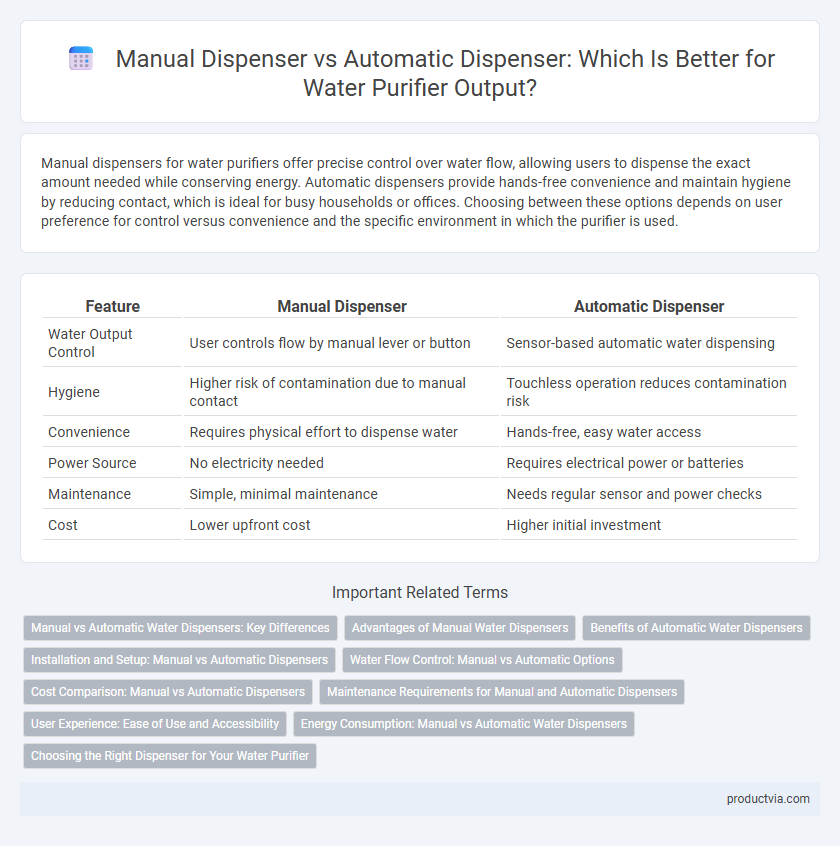Manual dispensers for water purifiers offer precise control over water flow, allowing users to dispense the exact amount needed while conserving energy. Automatic dispensers provide hands-free convenience and maintain hygiene by reducing contact, which is ideal for busy households or offices. Choosing between these options depends on user preference for control versus convenience and the specific environment in which the purifier is used.
Table of Comparison
| Feature | Manual Dispenser | Automatic Dispenser |
|---|---|---|
| Water Output Control | User controls flow by manual lever or button | Sensor-based automatic water dispensing |
| Hygiene | Higher risk of contamination due to manual contact | Touchless operation reduces contamination risk |
| Convenience | Requires physical effort to dispense water | Hands-free, easy water access |
| Power Source | No electricity needed | Requires electrical power or batteries |
| Maintenance | Simple, minimal maintenance | Needs regular sensor and power checks |
| Cost | Lower upfront cost | Higher initial investment |
Manual vs Automatic Water Dispensers: Key Differences
Manual water dispensers require users to physically operate a lever or button to release water, offering precise control over the amount dispensed and typically costing less upfront. Automatic water dispensers use sensors or touchless mechanisms to deliver water, enhancing convenience, hygiene, and often featuring adjustable temperature settings. Key differences include user interaction, maintenance requirements, and energy consumption, with automatic dispensers generally providing a more modern, hands-free experience.
Advantages of Manual Water Dispensers
Manual water dispensers offer precise control over the water output, reducing wastage and enabling users to fill containers of varying sizes efficiently. They require no electricity, making them highly reliable and cost-effective for use in areas with limited power access. The simple design minimizes maintenance needs and often leads to greater durability compared to automatic dispensers.
Benefits of Automatic Water Dispensers
Automatic water dispensers offer hands-free operation, reducing the risk of contamination and ensuring hygienic water output. They provide consistent water flow and temperature control, enhancing user convenience and efficiency. Energy-efficient models also feature smart sensors that minimize water wastage, making them eco-friendly and cost-effective over time.
Installation and Setup: Manual vs Automatic Dispensers
Manual dispensers require simple installation, often involving basic connections to a water source and minimal setup, making them quick to install without professional assistance. Automatic dispensers typically demand more complex installation, including electrical wiring and integration with sensors, which may necessitate professional setup to ensure proper functioning. While manual systems offer straightforward installation, automatic dispensers provide advanced features that require careful configuration for optimal performance.
Water Flow Control: Manual vs Automatic Options
Manual dispensers offer precise water flow control through user-operated taps, allowing for tailored dispensing volume but requiring physical effort and constant attention. Automatic dispensers utilize sensors or buttons to regulate water output, ensuring consistent flow rates and hands-free operation that enhances hygiene and convenience. Choosing between manual and automatic flow control depends on preferences for user involvement, accuracy, and maintenance ease in water purification systems.
Cost Comparison: Manual vs Automatic Dispensers
Manual water dispensers typically incur lower upfront costs and minimal maintenance expenses, making them a budget-friendly choice for households. Automatic dispensers involve higher initial investment due to built-in sensors and electronic components, and they may require periodic servicing to maintain functionality. Evaluating long-term cost-effectiveness depends on usage frequency, with manual dispensers favoring low-cost operation and automatic models offering convenience at a premium price.
Maintenance Requirements for Manual and Automatic Dispensers
Manual water dispensers require regular cleaning of spouts and drip trays to prevent bacterial buildup, with minimal mechanical parts that reduce repair frequency. Automatic dispensers involve electronic components such as sensors and pumps, necessitating periodic inspections and potential technical servicing to maintain functionality. Both types demand filter replacements based on manufacturer guidelines, but automatic dispensers often include alerts for maintenance, enhancing user convenience.
User Experience: Ease of Use and Accessibility
Manual dispensers require physical effort to operate, which can be challenging for elderly or disabled users, while automatic dispensers offer hands-free convenience, improving accessibility. Automatic dispensers often feature touchless sensors that reduce contamination risks and provide consistent water flow without manual control. Manual dispensers may be more affordable and simpler to maintain, but automatic systems enhance overall user experience by combining ease of use with hygienic benefits.
Energy Consumption: Manual vs Automatic Water Dispensers
Manual water dispensers consume no electricity as they rely on user-operated mechanisms to release water, making them highly energy-efficient and ideal for off-grid use. Automatic water dispensers, equipped with sensors, pumps, and electronic controls, require continuous power, leading to higher energy consumption and ongoing electricity costs. Choosing between manual and automatic models hinges on balancing convenience against energy efficiency and environmental impact.
Choosing the Right Dispenser for Your Water Purifier
Manual dispensers offer precise control over water flow and are typically more affordable, making them ideal for users prioritizing simplicity and cost-effectiveness. Automatic dispensers provide touch-free convenience and enhanced hygiene by minimizing contact, suited for high-traffic areas or families with children. Selecting the right dispenser depends on user preferences for convenience, budget, and the desired level of sanitation in water dispensing.
Manual Dispenser vs Automatic Dispenser for water output Infographic

 productvia.com
productvia.com